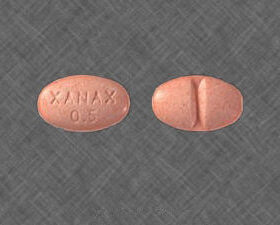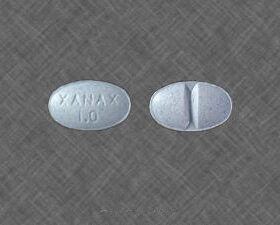- Your cart is empty
- Continue Shopping

Shop
Buy Xanax Online
Anxietymedsusa.com is an online pharmacy & health information site. Where you can easily buy Xanax online with same-day delivery. Additionally get all brands like Adderall, Oxycontin, Tramadol and More generic medicines In the USA.
What is Xanax?
Xanax is the trade name for alprazolam, which is a benzodiazepine medication available by prescription. Benzodiazepines are central nervous system (CNS) depressants that produce sedative, hypnotic, anxiolytic, anticonvulsant, and muscle relaxant effects.
Xanax is primarily prescribed for the treatment of anxiety and panic disorders. It works by enhancing the effects of gamma-aminobutyric acid (GABA), a neurotransmitter that inhibits excessive activity in the brain and promotes calmness and relaxation. When GABA levels are increased by Xanax, feelings of anxiety, stress, and nervousness are reduced.
Xanax comes in immediate and extended-release oral tablet forms. It is available in generic versions and under the brand name Niravam as an orally disintegrating tablet.
How Does Xanax Work?
Xanax contains alprazolam, which belongs to a class of medications called benzodiazepines. Benzodiazepines work by enhancing the effects of a neurotransmitter called gamma-aminobutyric acid (GABA) in the brain.
GABA is responsible for reducing neuronal excitability and activity in the central nervous system. When GABA attaches to its receptors, it triggers an inhibitory response that slows down and calms the firing of neurons in the brain and spinal cord. This produces a drowsy, calming effect that helps relieve symptoms of anxiety and panic.
By binding to benzodiazepine receptors that are part of GABA receptors, alprazolam boosts the inhibitory effects of GABA. This results in more GABA activity and reduced neuronal firing. Xanax provides rapid anti-anxiety, anti-insomnia, anticonvulsant, and muscle relaxant effects by suppressing neuron activity.
Some of the effects of Xanax on the body and brain include:
- Decreased anxiety, worry, and panic
- Muscle relaxation
- Sedation and drowsiness
- Lowered inhibitions
- Anticonvulsant effects
- Impaired coordination and balance
- Slurred speech
- Poor concentration and clouded thinking
- Short-term memory problems
- Slowed breathing and heart rate
Approved Uses of Xanax
Xanax is most commonly prescribed for generalized anxiety disorder (GAD) and panic disorder.
For GAD, the typical starting dose of Xanax is 0.25-0.5 mg taken 3 times per day. This dosage may be increased every 3-4 days in increments of 0.5 mg per day until symptoms are controlled. The maximum daily dose for GAD is 4 mg.
For panic disorder, the initial dose is 0.5 mg taken 3 times per day. This can be gradually increased if needed to a maximum daily dose of 10 mg.
Xanax is also sometimes prescribed off-label for social anxiety disorder and insomnia at similar dosages as panic disorder. For situational anxiety or panicking episodes, Xanax may be taken as needed at 0.25-0.5 mg doses.
Off-label uses of Xanax
While Xanax is only FDA-approved for treating panic disorder and generalized anxiety disorder (GAD), it is commonly prescribed off-label for other conditions including:
Anxiety
Xanax works quickly to provide short-term relief of anxiety symptoms. However, it is usually not recommended as a long-term treatment since benzodiazepines can cause dependence and withdrawal symptoms. Other medications like SSRIs or psychotherapy are generally preferred for long-term anxiety treatment.
Depression
Xanax is sometimes used off-label alongside antidepressants to provide temporary relief of symptoms like restlessness, agitation, and insomnia in depressed patients.
While benzodiazepines like Xanax may help manage acute symptoms, they are not an appropriate long-term treatment for depression. They do not treat the underlying cause of depression like antidepressants or therapy can.
Insomnia
Difficulty sleeping is another common off-label use for Xanax. Its sedating effects can help patients fall asleep faster and stay asleep through the night.
However, benzodiazepines like Xanax can disrupt normal sleep architecture and are not recommended for long-term insomnia treatment. They may cause dependence which can make insomnia worse upon withdrawal. Safer alternatives include cognitive behavioral therapy for insomnia (CBT-I), improved sleep habits, or medications specifically approved for insomnia.
Side effects of Xanax
Xanax can cause a variety of side effects, even when taken as prescribed. Several common side effects include:
- Drowsiness, fatigue, and feelings of lethargy
- Impaired coordination and balance
- Slurred speech
- Confusion
- Memory problems
- Depression
- Headaches
- Nausea
- Changes in sex drive
- Constipation
- Difficulty urinating
Overdose and Interactions
Taking too much Xanax can result in an overdose. Overdose symptoms include extreme drowsiness, confusion, impaired coordination, diminished reflexes, coma, and even death. Combining Xanax with alcohol or other drugs dramatically increases the risks.
Xanax interacts with numerous substances and should not be combined with:
- Opioids like oxycodone or heroin – further depress breathing and increase sedation. The combination can be fatal.
- Antihistamines like diphenhydramine – also have depressant effects and enhance drowsiness.
- Antidepressants like fluoxetine or citalopram – can increase Xanax levels in the blood to dangerous amounts.
- Barbiturates like phenobarbital – both depress the central nervous system and the effects compound each other.
- Muscle relaxants like cyclobenzaprine or tizanidine – since they have additive effects.
- Sleep medications like zolpidem – resulting in extreme sedation.
Precautions and Warnings
Xanax has important safety warnings and precautions that should be considered before taking it.
Who Should Not Take Xanax
- Pregnant women – Taking Xanax during pregnancy can cause birth defects and withdrawal symptoms in newborns.
- Breastfeeding women – Xanax passes into breast milk and can affect the baby. Nursing mothers should not take Xanax.
- People with narrow-angle glaucoma – Xanax can make this eye condition worse.
- People with severe liver impairment – Xanax is extensively metabolized by the liver. Significant liver dysfunction may require dosage adjustments.
- People with lung diseases – Benzodiazepines like Xanax may worsen respiratory conditions like COPD.
- People with sleep apnea – Xanax can exacerbate sleep apnea.
- Children under 18 years old – The safety and effectiveness of Xanax have not been established in pediatric patients.









